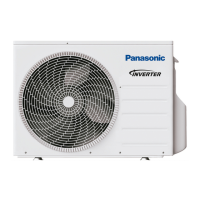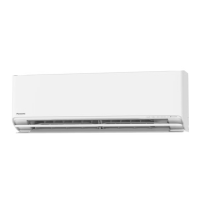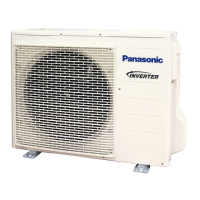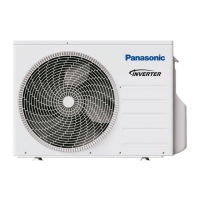Why my Panasonic CU-2Z35TBE makes cracking sound?
- RRobert GarciaAug 30, 2025
A cracking sound during operation of your Panasonic Air Conditioner is due to temperature changes causing the expansion or contraction of the unit.
Why my Panasonic CU-2Z35TBE makes cracking sound?
A cracking sound during operation of your Panasonic Air Conditioner is due to temperature changes causing the expansion or contraction of the unit.
Why is my Panasonic CU-2Z35TBE noisy?
If your Panasonic Air Conditioner is noisy during operation, check whether the unit has been installed at an incline. Also, make sure that the front panel is closed properly.
How to improve HEAT/COOL efficiency in Panasonic Air Conditioner?
If your Panasonic Air Conditioner isn't operating efficiently in HEAT/COOL mode, ensure that you set the temperature correctly, close all doors and windows, clean or replace the filters, and clear any obstructions at the air inlet and outlet vents.
Why does my Panasonic CU-2Z35TBE Air Conditioner outdoor unit emit water or steam?
The outdoor unit emits water or steam because condensation or evaporation occurs on the pipes.
Why is the TIMER indicator always on in my Panasonic CU-2Z35TBE Air Conditioner?
The TIMER indicator is always on because the timer setting repeats daily once set.
How to improve HEAT/COOL mode efficiency in Panasonic CU-2Z35TBE Air Conditioner?
If your Panasonic Air Conditioner isn't working efficiently in HEAT/COOL mode, ensure the temperature is set correctly, all doors and windows are closed, the filters are clean or replaced, and there are no obstructions at the air inlet and outlet vents.
What to do if my Panasonic CU-2Z35TBE doesn't receive the remote control signal?
If the Panasonic Air Conditioner unit does not receive the signal from the remote control, ensure that the receiver is not obstructed. Note that certain fluorescent lights may interfere with the signal transmitter; consult an authorised dealer.
Why does dust accumulate on the wall near my Panasonic Air Conditioner?
Dust accumulation on the wall near your Panasonic Air Conditioner may be due to air circulation or static electricity generated by the air conditioner.
What to do if Panasonic CU-2Z35TBE Air Conditioner remote control does not work?
If the remote control for your Panasonic Air Conditioner isn't working, first ensure that the batteries are inserted correctly. If the display is dim or the transmission signal is weak, try replacing the batteries.
What to do if Panasonic CU-2Z35TBE doesn't receive signal from remote control?
If your Panasonic Air Conditioner isn't receiving the signal from the remote control: * Ensure that the receiver is not obstructed. * Be aware that certain fluorescent lights may interfere with the signal transmitter.
Step-by-step guide to insert batteries into the remote control for operation.
Instructions on how to set the clock on the remote control for accurate timer functions.
Instructions on how to turn the air conditioner on and off using the remote control.
Guide on choosing the desired operating mode (AUTO, HEAT, COOL, DRY) for comfort.
How to adjust the desired temperature using the remote control buttons.
Important warnings regarding installation, handling, and potential hazards for indoor and outdoor units.
Safety guidelines for using and storing the remote control, including battery precautions.
Precautions related to the network adaptor, including proximity to medical equipment.
Safety measures for power cords, outlets, and preventing electrical hazards.
Cautions for cleaning, placement, and general unit operation to prevent damage or injury.
Specific cautions for remote control usage, like battery types and long-term storage.
Cautions for network adaptor installation and operation, including power supply and timer settings.
Warning about R32 refrigerant being flammable and the risk of fire if leaked.
Safety requirements for unit installation location and ventilation to prevent hazards.
Specifics on installation work, piping, and tools required for R32 refrigerant.
Requirements for trained personnel, refrigerant recovery, and safety measures for handling flammable refrigerants.
Requirements for personnel knowledge, training, and understanding of refrigerant regulations.
Guidelines for installation space, pipework protection, and compliance with regulations.
Qualifications and responsibilities of trained personnel performing servicing on the unit.
Safety precautions and procedures for working on systems with flammable refrigerants.
Methods and equipment for checking the presence of refrigerant and detecting leaks safely.
Requirement for fire extinguishing equipment during servicing operations.
Rules for eliminating ignition sources when working with flammable refrigerants.
Ensuring adequate ventilation during servicing to disperse released refrigerant safely.
Checks for electrical components, refrigerant charge, ventilation, and equipment markings during servicing.
Safety checks for electrical components, including capacitor discharge and earth bonding.
Procedures for repairing sealed components, ensuring electrical isolation and leak detection.
Guidelines for repairing intrinsically safe components in potentially hazardous environments.
Ensuring cabling is protected from wear, corrosion, and environmental effects.
Prohibiting ignition sources when searching for refrigerant leaks and using appropriate detectors.
Approved methods for detecting refrigerant leaks, including sensitivity and calibration requirements.
Procedures for safely removing and evacuating refrigerant from the system during repairs.
Steps for charging the system with refrigerant, including contamination prevention and leak testing.
Steps for safely decommissioning the unit, including refrigerant recovery and electrical isolation.
Guidelines for labelling de-commissioned equipment and indicating flammable refrigerant presence.
Detailed steps for safe recovery of refrigerant, including cylinder use, equipment checks, and oil draining.
Technical specifications for the Network Adaptor, including model, voltage, and wireless standards.
Instructions on how to control the direction of airflow using the remote control.
Guide on setting the fan speed for optimal cooling and noise reduction.
How to activate powerful cooling or quiet operation modes for specific needs.
Explains the nanoe X feature for air purification, deodorization, and skin moisturization.
How to use the MILD DRY mode to reduce air dryness during COOL mode.
How to activate sleep mode for comfortable sleeping with automatic temperature adjustment.
Guide on setting the ON and OFF timers for automatic unit operation.
Recommended temperature settings for HEAT and COOL modes to save energy.
Steps to establish a wireless connection between the air conditioner and the home network.
Instructions for downloading and installing the Panasonic Comfort Cloud app on smartphones.
Guide for new users to create a Panasonic ID for app registration and control.
Process for registering a new air conditioner device within the Panasonic Comfort Cloud app.
Step-by-step guide to set up the network connection using the remote control and app.
Detailed steps to connect the air conditioner to the router using the WPS mode.
Detailed steps to connect the air conditioner using the Access Point (AP) mode.
Steps to select the Wi-Fi network SSID and enter the password for connection.
Guide to select the air conditioner model and set a password for registration.
Finalizing registration, naming the unit, and accessing app features like energy monitoring.
Answers to common questions regarding app installation and initial unit connection.
Troubleshooting tips for unstable wireless signals and checking signal strength.
Procedures for replacing routers, smartphones, control boards, or transferring unit data.
Detailed explanation of AUTO, HEAT, COOL, and DRY operation modes for single and multi-split systems.
Recommended temperature settings for HEAT and COOL modes to save energy.
How airflow direction behaves in different modes (COOL/DRY, HEAT, MILD DRY).
Explanation of the auto restart feature after a power failure, and its limitations with timers.
How to clean the indoor unit's front panel and body with recommended materials.
Instructions for cleaning the air filters, including washing, drying, and replacement.
How to clean the outdoor unit and ensure the drain pipe is clear of blockages.
Explanations for normal operational symptoms that may appear as malfunctions.
Checks to perform before calling for servicing, covering operation, noise, and remote control issues.
Steps to take if the remote control is missing, malfunctioning, or indicators are too bright.
Guidelines for seasonal checks after extended non-use and preparing for long periods of inactivity.
Conditions requiring professional service, such as abnormal noise or electrical issues.
List of diagnostic codes and their corresponding abnormalities or protection controls for troubleshooting.
Information on responsible collection and disposal of old equipment and used batteries, especially in the EU.
Details on how the product automatically updates its firmware via the internet.
Information regarding the software licenses, including open-source components and their terms.
Lists software used, including third-party and open-source components, with relevant licenses.
Specific license terms for the WPA Supplicant software component.
Details on the FreeRTOS license, including its modifications and exceptions.
Exception text for the FreeRTOS GNU General Public License, defining terms for combining modules.
The full terms and conditions of the GNU General Public License Version 2.0.
Conditions and requirements for distributing the Program and its derivative works under the GPL.
Disclaimer of warranty and limitation of liability for the software provided.
States that the air conditioner uses a biocidal product for air purification.
| Cooling Capacity | 3.5 kW |
|---|---|
| Heating Capacity | 4.0 kW |
| Power Supply | 220-240 V, 50 Hz |
| Refrigerant | R32 |
| Noise Level (Outdoor Unit) | 48 dB |












